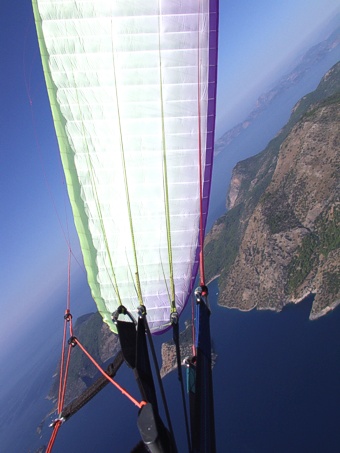Over the last year there have been several fatal accidents that appear to have been caused directly by spiral dives. Most of the cases involve low-airtime or intermediate pilots flying gliders rated DHV1 or DHV1-2. The pilot, often receiving instruction on the radio or simply trying out spirals on their own, enters a severe spiral, and continues in the spiral all the way to the ground. With a descent rate of 10-20m/s impact with the ground, and even water is mostly fatal.
This year alone I have heard of three such fatalities in France, two in German, one in Italy and one over water in Turkey. All the accidents involved gliders from different brands, the only common thread being the fact that all were intermediate wings certified DHV1 or DHV1-2.
The problem is not new. I remember hearing about the firts fatal accident from a spiral dive in St André Les Alpes about eight years ago. The pilot was also under instruction, and on an XC course with a very experienced instructor. He entered a spiral from which he never recovered.
What is spiral stability?
Certified gliders are tested for spiral stability by the certifying organisation, be it AFNOR or DHV. The test pilot puts the glider into a spiral in a standard way, as defined by the test protocol, and then releases the brakes. If the glider pulls out of the spiral dive automatically without input of the pilot, then the glider passes the test.
If the glider continues in the spiral with the same rate of turn the glider is said to be "spiral neutral". If the glider actually accelerates into the spiral once the pilot released the brakes then the glider is spirally unstable.
Beginner gliders are required to recover immediately, on their own, and advanced gliders are allowed to be spirally unstable as long as it is easily controllable. Intermediate gliders lie somewhere between these two extremes.
All this sounds straightforward enough. So why is it that people are having accidents involving spiral dives on certified wings? To find the answer, we have to look deeper into the background, as what appears to be simple on the surface is actually much more complicated.
History
In 1997 a team from the technical department of the DHV, headed by Hannes Weininger, made an in-depth investigation into the spiral stability of gliders. The spiral dive was at the time already considered a problem, particularly on low aspect ratio gliders. The DHV were finding that many gliders were spirally unstable. During testing the DHV were failing nearly all low aspect ratio gliders as a result of their spiral dive characteristics.
In the end the DHV came to the conclusion that practically any low aspect ratio glider would fail if the descent rate was high enough. As a result they decided to fix the descent rate at a level they felt was more reasonable. They measured the spiral dives made by recreational pilots during SIV courses and found that most spiral dives didin't go above a 14m/s descent rate. So now the DHV test is based on recovery from normal spiral with a descent rate of 14m/s.
|

The DHV test also says that even if a glider is spirally unstable in spirals of over 14m/s then the wing must be easy to control in order to achieve a DHV1 or DHV1-2 grade. During the courses of this investigation the DHV also discovered that there are two types of spiral dives: the "standard spiral" and the "over-the-nose spiral".
The Standard Spiral
To enter a standard spiral, apply one brake smoothly and progressively. As you do this the bank angle of the glider tends to increase progressively in line with the severity of the spiral. The leading edge is typically at 45 degrees to the horizon, and it is normally difficult to exceed a descent rate of 15m/s.
Over-the-nose Spiral
This is achieved by doing one 360-degree turn in a standard spiral and then applying one brake abruptly so that the leading edge rotates through 45 degrees and faces towards the ground. This is very similar to the SAT entry, though when you enter a SAT you apply the brake for longer so that the leading edge goes past the point where it is facing the ground. In an over the nose spiral the speed of descent is very high indeed, normaly over 20m/s.
The DHV's Conclusion
As a result of the investigation, the magazine DHV Info published two articles on the subject - one by Christoph Kirsch (Freex designer) and another by Stefan Muller (Firebird designer) during 1988. Basically both said that the spiral dive was a dangerous manoeuvre and should only be practiced in emergency situations. They also pointed out that the DHV only tested gliders to a descent rate of 14m/s and that above this descent rate the stability characteristics could be very different.
|
